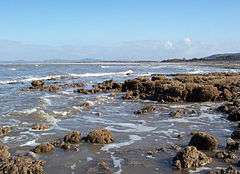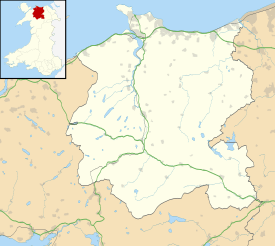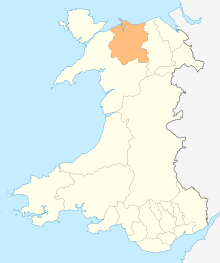Llanddulas and Rhyd-y-foel
Llanddulas and Rhyd-y-foel (Welsh: Llanddulas a Rhyd-y-foel) is a community in Conwy County Borough, in Wales. It is located on the coast of Liverpool Bay, at the mouth of the Afon Dulas, 2.7 miles (4.3 km) west of Abergele, 3.6 miles (5.8 km) east of Colwyn Bay and 9.0 miles (14.5 km) east of Conwy. As the name suggests, it consists of the villages of Llanddulas and Rhyd-y-foel. At the 2001 census the community had a population of 1,572,[1] reducing slightly to 1,542 at the 2011 census.[2]
Llanddulas and Rhyd-y-foel
| |
|---|---|
 Honeycomb worm reef at Llanddulas | |
 Llanddulas and Rhyd-y-foel Location within Conwy | |
| Population | 1,542 (2011) |
| OS grid reference | SH9078 |
| Community |
|
| Principal area | |
| Ceremonial county | |
| Country | Wales |
| Sovereign state | United Kingdom |
| Post town | ABERGELE |
| Postcode district | LL22 |
| Dialling code | 01492 |
| Police | North Wales |
| Fire | North Wales |
| Ambulance | Welsh |
| UK Parliament | |
| Senedd Cymru – Welsh Parliament |
|
Now derelict, Gwrych Castle stands on the hillside to the east of Llanddulas. Built between 1812 and 1822 by Lloyd Hesketh Bamford-Hesketh, it has been described as a "spectacular and romantic flight of gothic fancy," and was an attempt to create a replica of an Edwardian fortress.[3] The castle contains 18 towers, and is surrounded by terraced gardens and woodland, with gothic park walling, lodges and towers. The total frontage is over 0.8 miles (1.3 km) in length, and has been described as "one of the finest examples of its date in Britain" by Cadw. It is Grade I listed.[4] In November 2011, planning permission was granted to convert the building into a hotel, conference centre and spa.[5][6]
Saint Cynbryd's Church, in Llanddulas, dates from 1868, and was designed by George Edmund Street, who was also responsible for the Royal Courts of Justice in London. It is on the site of an earlier medieval church which had been rebuilt in 1732, and was commissioned by Robert Bamford-Hesketh of Gwrych Castle. It is described by Cadw as being "of subtle sophistication and quiet mastery" and is Grade II* listed.[7] Similarly listed is Plas Tan-yr-ogof, a farmhouse on the Gwrych estate, built in 1819, which was used for a while as a night club.[8]
In 2008, a 1,148 feet (350 m) long honeycomb worm reef was discovered on the beach at Llanddulas,by fishery officer Philip Capper of the North Western and North Wales sea fisheries committee after an absence of 60 years. The worms are common to the Mediterranean Sea, and are rare in the British Isles, but found at a number of sites on western and southern coasts. They create the reefs by forming tightly packed tubes from sand and shell particles on top of rocky shores, which then provide a haven for barnacles, crabs, limpets, mussels, periwinkles, sea anemones and whelks.[9][10]
Pen-y-corddyn-mawr is a hillfort located on a limestone plateau above Rhyd-y-foel, where Roman artefacts have been unearthed. Lead mines nearby are thought to have been worked by the Romans, and were still in use in the 1820s, when they provided the lead for Gwrych Castle's windows.[11] The limestone hill of Cefn yr Ogof 204 metres (669 feet)stands above the village. Nearby is the crag of Craig y Forwyn.
References
- "Census 2001: Parish Headcounts: Conwy". Neighbourhood Statistics. Office for National Statistics. Retrieved 9 April 2013.
- "Community/Ward population 2011". Retrieved 21 May 2015.
- "Gwrych Castle, Garden, Abergele". Coflein. Royal Commission on the Ancient and Historical Monuments of Wales. Retrieved 13 April 2013.
- Cadw. "Gwrych Castle including attached walls and towers and Stable Block (Grade I) (231)". National Historic Assets of Wales. Retrieved 2 April 2019.
- "Gwrych Castle Gets Hotel Extension Permission". Architects Choice. Retrieved 13 April 2013.
- "Derelict Gwrych Castle to Become Luxury Hotel". Daily Post. 22 November 2012. Retrieved 13 April 2013.
- Cadw, "Parish Church of St Cynbryd (Grade II*) (19024)", National Historic Assets of Wales, retrieved 2 April 2019
- Cadw. "Plas Tan-yr-Ogof including adjoining walls and arches to E and W (Grade II*) (19040)". National Historic Assets of Wales. Retrieved 2 April 2019.
- "Returning Worms Build Coastal Reef". British Broadcasting Corporation. 10 March 2008. Retrieved 13 April 2013.
- "Action Plans: Honeycomb Worm Reef". Biodiversity Action Reporting System. Retrieved 13 April 2013.
- "Pen y Corddyn Mawr: A Romano British Hillfort and Votive Site". Kanovium Project. Archived from the original on 9 August 2013. Retrieved 13 April 2013.
External links
![]()
